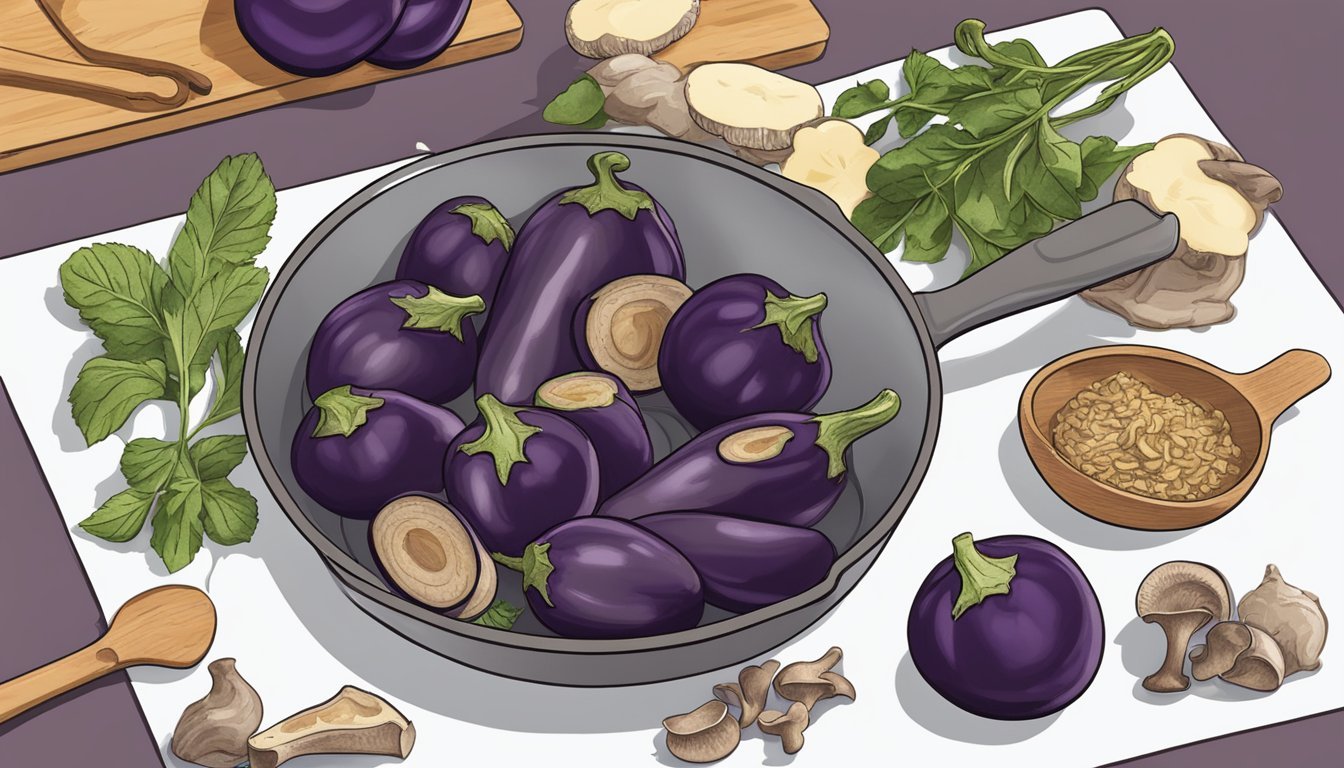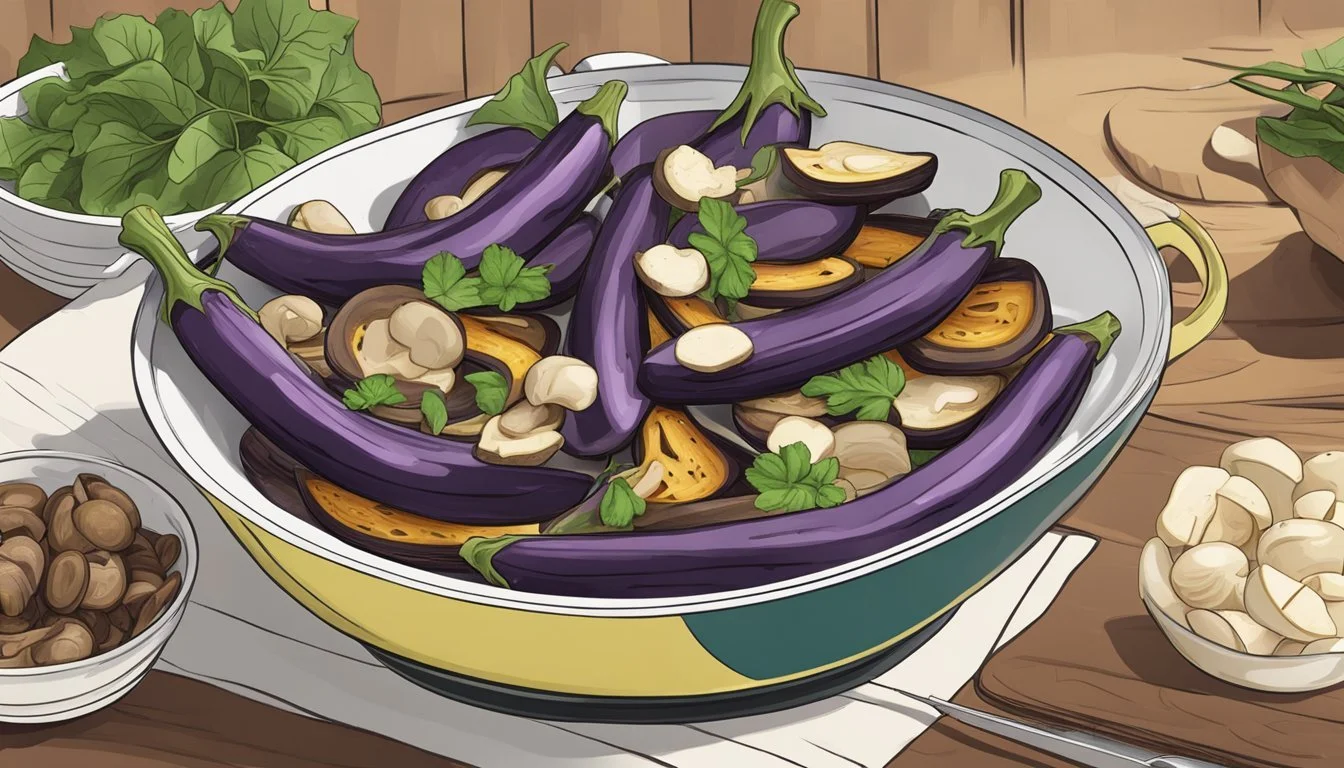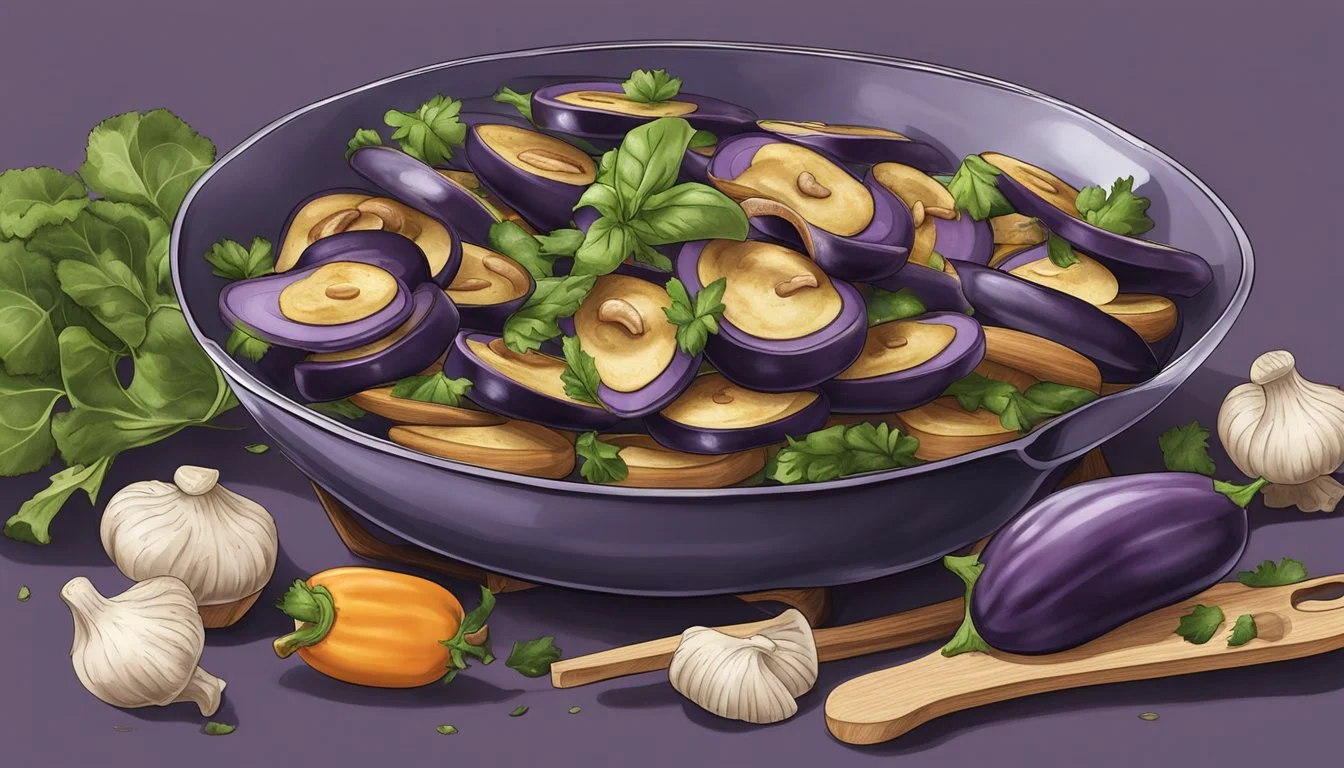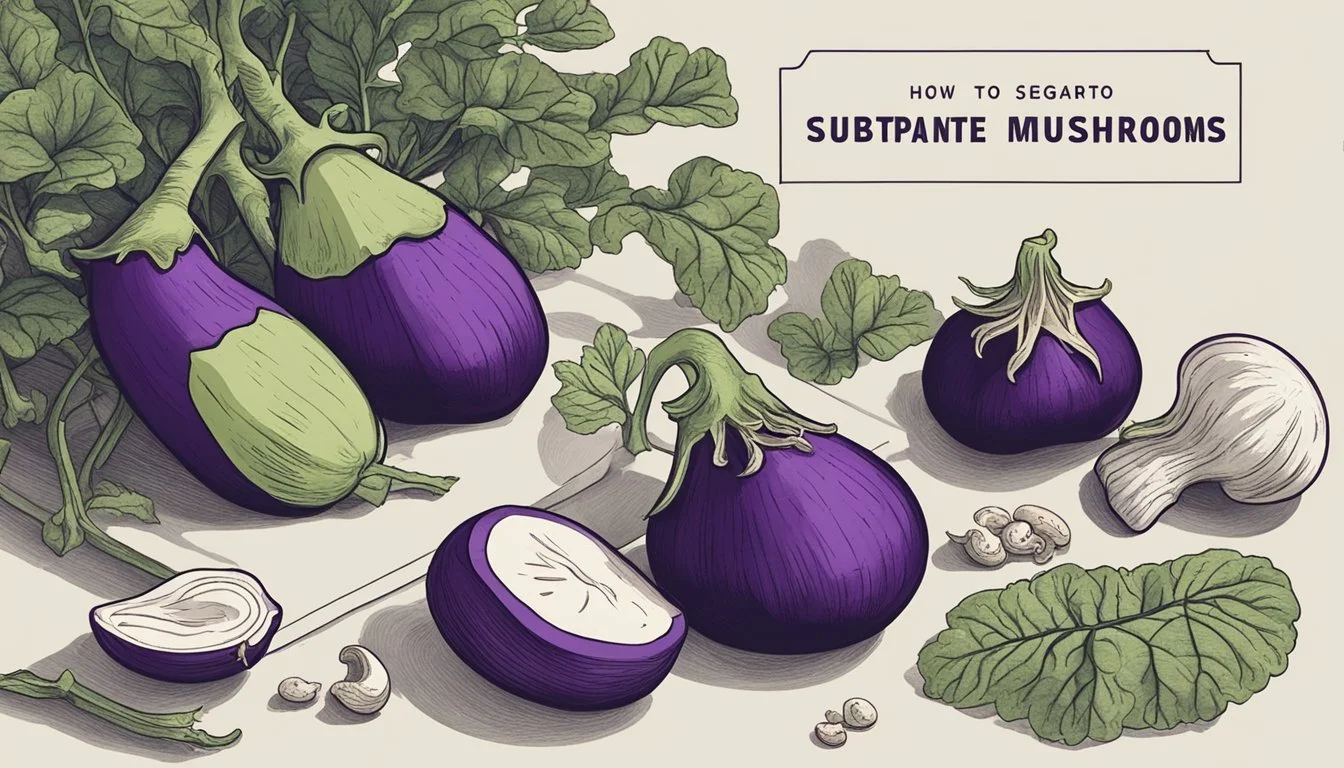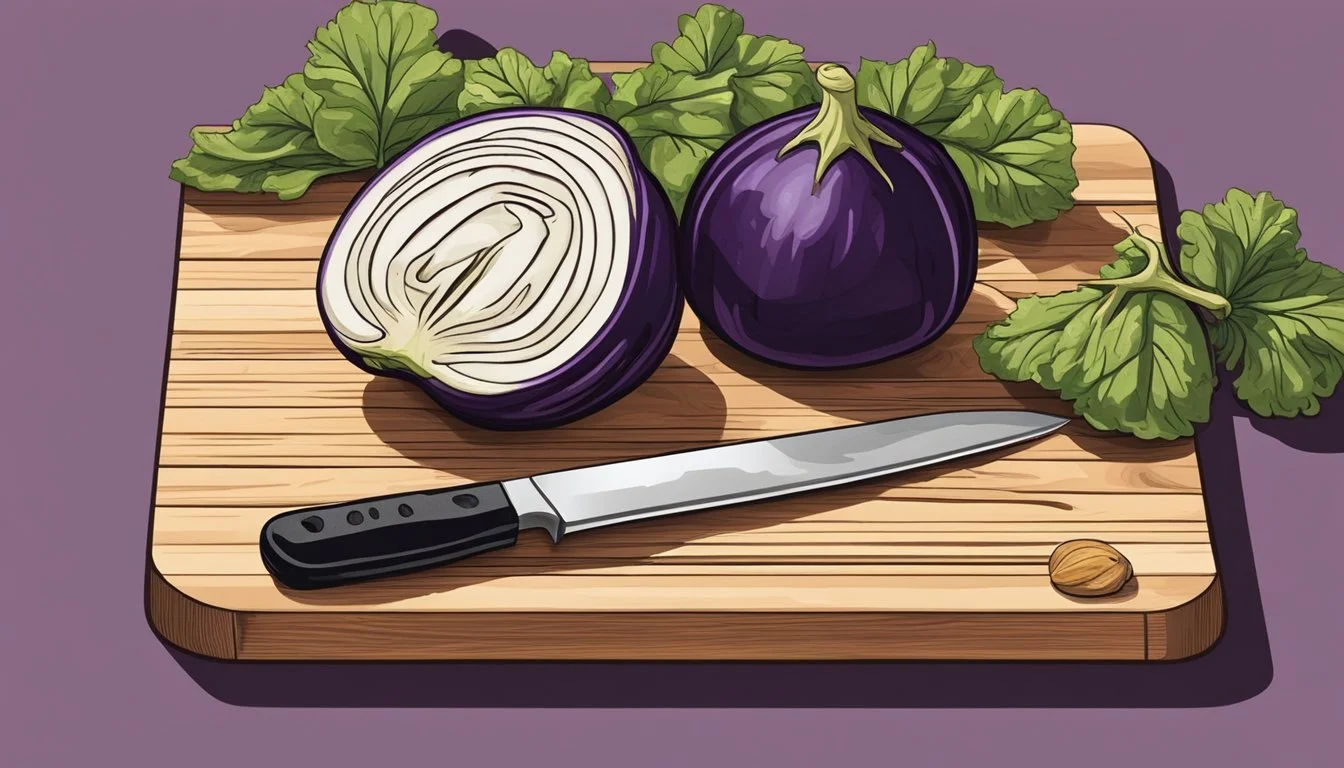How to Substitute Eggplant for Mushrooms
A Guide for Seamless Swaps in Recipes
Eggplant (What wine goes well with eggplant?) is a versatile vegetable commonly used in a variety of dishes around the world, from Italian eggplant (What wine goes well with eggplant?) parmesan (What wine goes well with eggplant parmesan?) to Middle Eastern baba ganoush. Distinguished by its spongy texture, it has the remarkable ability to soak up flavors and oils, making it a suitable candidate for replacing mushrooms (What wine goes well with mushrooms?) in recipes. This feature is particularly beneficial for those who are looking to avoid mushrooms due to allergies, dietary preferences or simply for a change in taste or texture in their cooking.
When substituting eggplant for mushrooms, cooks will find that the eggplant's mild flavor and meaty texture provide a similar mouthfeel and bulk. Eggplants can seamlessly integrate into dishes traditionally calling for mushrooms, absorbing the surrounding flavors and contributing to the overall savoriness of the meal. They can be prepared in various ways such as grilling, baking, roasting, or sautéing, making them a flexible option in recipes ranging from stews (What wine goes well with stews?) to stir-fries.
Understanding the proper methods of preparation and the best types of dishes for eggplant substitutions can ensure that the resulting meals retain the desired taste and texture. Cooks should consider factors like cooking times and spices used, as eggplants may require different handling to elicit the best results. With the right approach, eggplant can easily become a go-to substitute for mushrooms in many recipes.
Understanding Eggplant
Before diving into substituting eggplant for mushrooms, it's essential to understand the unique aspects of eggplant that make it such a versatile vegetable in culinary applications.
Eggplant Varieties and Characteristics
There are multiple varieties of eggplant, each with distinct characteristics. The most common type found in supermarkets is the Globe eggplant, often referred to as the American or Italian eggplant. It is known for its large, bulbous shape and deep purple color. Another variety is the Italian eggplant, slightly smaller with a thinner skin and a less bitter flavor. The Indian eggplant is small and round with a deep purple to black skin, often used in dishes like Baingan Bharta. For those looking for a different aesthetic, the White eggplant offers a creamy texture with a skin that's a striking white color; it's also known as the garden egg.
Globe Eggplant
Color: Dark purple
Size: Large and bulbous
Common Use: General cooking
Italian Eggplant
Color: Dark purple to black
Size: Medium, slightly smaller than the globe
Common Use: Italian dishes
Indian Eggplant
Color: Deep purple to black
Size: Small and round
Common Use: South Asian cuisine
White Eggplant
Color: White
Size: Various, often smaller than globe
Common Use: Decorative and cooking, more delicate in taste
Nutritional Profile of Eggplant
Eggplants are not only versatile in terms of their uses but also high in fiber and rich in antioxidants. They have a variety of vitamins such as vitamin C, vitamin K, and vitamin B6, and are a healthy addition to any diet.
Nutritional Highlights of Eggplant:
High in Fiber
Antioxidants: Nasunin, Chlorogenic acid
Vitamins: C, K, B6
Eggplant Flavor and Texture
The flavor of an eggplant can be described as mildly earthy with a slightly bitter taste that can be reduced by salting and rinsing before cooking. The texture of eggplants is often referred to as spongy, which allows it to absorb flavors well. When cooked, it can range from meaty and substantial in dishes like eggplant Parmesan to creamy when blended into dips or spreads. This spongy texture and ability to become creamy make it a suitable substitute for mushrooms in various recipes.
Mushrooms and Their Unique Qualities
Mushrooms are renowned for their earthy flavor and meaty texture, which make them versatile in various dishes ranging from salads to stews. This section will delve into the types of mushrooms commonly used in cooking, their distinct flavor and texture profiles, and their wide-ranging culinary applications.
Common Types of Mushrooms
Portobello Mushrooms: They are large, brown mushrooms known for their rich, meaty texture. Ideal on pizzas or as a meat substitute.
Shiitake Mushrooms: These mushrooms have a distinct umami flavor and a slightly chewy texture. They are often used in soups and Asian-inspired dishes.
Button Mushrooms: Also known as white mushrooms, they are mild in flavor and are commonly used in a variety of Western-style dishes.
Texture and Flavor Profiles
Mushrooms possess a unique meaty texture, which can vary from soft to chewy. The flavor spectrum includes:
Earthy flavor: Typically found in portobello mushrooms, lending a deep, rich taste to the dish.
Nutty flavor: Common in shiitake mushrooms, adding a complex, savory note to the meal.
Culinary Uses of Mushrooms
Mushrooms are culinary chameleons, adept at enhancing the flavor complexity of a dish or even standing in as the centerpiece. They can be incorporated into:
Salads and Soups: Adds texture and an earthy depth.
Stews and Pizzas: Contributes a meaty bite and hearty feel.
Various Cooking Techniques: Sautéing, grilling, or baking mushrooms brings out their natural flavors without overshadowing other ingredients.
Substituting Eggplant for Mushrooms
Eggplant can effectively replace mushrooms in a variety of dishes, from pasta to stews, due to its ability to mimic the texture of mushrooms when cooked properly. The key lies in preparing the eggplant to ensure it delivers a similar savory experience.
Factors to Consider in Substitution
Flavor Profile: Eggplant has a milder flavor compared to some mushrooms but tends to absorb other tastes well, which makes it suitable for dishes that rely on the intermingling of flavors.
Texture: Mushrooms have a distinct texture that varies from type to type. When substituting with eggplant, it's important to achieve a comparable texture by cooking the eggplant to the point where it's tender but not mushy, aiming for a meaty bite.
Type of Dish: Consider the role mushrooms play in the dish. If they're a principal ingredient, such as in mushroom stroganoff, eggplant can stand in as the star. In more complex dishes, like ratatouille (What wine goes well with ratatouille?), eggplant complements the other vegetables.
Preparing Eggplant as a Mushroom Substitute
Selection: Opt for firm, glossy eggplants with smooth skin.
Pre-treatment:
Salting: Dice or slice the eggplant and salt it to draw out moisture. Let it sit for about 20 minutes, then pat dry. This helps to reduce potential bitterness and achieve a more mushroom-like texture.
Blotting: If salting is not preferred, ensure to blot the eggplant pieces with a paper towel to remove excess moisture after cutting.
Cooking Methods:
Grilling or Roasting: Provides a charred, smoky flavor.
Frying or Sautéing: Helps attain a golden, caramelized exterior.
Baking: Suitable for dishes like eggplant parmesan or casseroles.
Recipe Adaptations and Considerations
Vegan and Vegetarian Options: Eggplant is a hearty substitute that can make a dish vegan or vegetarian-friendly when replacing mushroom-based components.
Pasta and Stews: Incorporate eggplant in these dishes as you would with mushrooms, adjusting cooking times as needed, until the eggplant has a similar consistency to the original mushroom ingredient.
Casseroles and Ratatouille: Eggplant can be layered or mixed in with other vegetables to add bulk and texture that mushrooms typically provide.
By taking note of these specific factors and adapting your cooking method accordingly, eggplant becomes a versatile and satisfying substitute for mushrooms in many culinary applications.
Alternative Vegetable Substitutes
When replacing eggplant with another vegetable for mushrooms, it's important to match the dish's flavor profile and cooking method with the chosen substitute.
Replacing Mushrooms in Various Dishes
In stir-fries, soups and stews, and baked dishes, zucchini (What wine goes well with zucchini?) is a versatile option. It has a neutral flavor and absorbs other flavors well. Tempeh and firm tofu, as they can be fried, roasted, sautéed, or baked, add a protein-rich choice for vegan and vegetarian dishes (What wine goes well with vegetarian dishes?).
Other Substitutes for Eggplant
Squash varieties like butternut or yellow squash can replace eggplant, particularly in soups, stews, and baked dishes.
Green tomatoes offer a tangy flavor and are suitable for frying or grilling.
Root vegetables such as carrots and turnips provide bulk and heartiness to a dish, working well roasted or stewed.
Pairing Substitutes with Appropriate Flavors
Use green and white squash in lighter, herb-infused dishes.
Add kalamata or black olives for a Mediterranean twist.
Incorporate canned artichoke hearts for a unique texture and slightly tangy taste.
Considerations for Texture and Cooking Methods
Considering the texture is key. For example:
Tofu should be pressed and possibly marinated to mimic mushrooms' meaty texture.
Okra has a mucilaginous texture, ideal in gumbos as a thickening agent.
Health and Dietary Implications
Substitutes like zucchini, squash, and carrots are low in calories and provide various vitamins and minerals.
Tofu and tempeh offer plant-based proteins and antioxidants, making them nutritious options for vegan and vegetarian diets.
Additional Tips for Vegetable Substitution
When substituting eggplant for mushrooms, the key factors to consider are how to enhance flavors, select the right vegetables for your dish, and integrate substitutes creatively into classic recipes.
Enhancing Flavor Through Cooking Techniques
A variety of cooking methods, such as grilling, caramelizing, and roasting, can heighten the natural flavors of eggplant. When grilled, eggplant develops a smoky taste that can closely mimic the earthy tones of mushrooms. Caramelized eggplant, with its sweet and rich profile, is excellent in dishes where a depth of flavor is desirable. Roasted eggplant achieves a concentrated flavor and tender texture that acts as a commendable stand-in for mushrooms' meaty quality.
Selecting the Right Substitute
The choice of an eggplant substitute for mushrooms hinges on both texture and flavor compatibility with the other ingredients. Consider the firmness of eggplant when selecting it as a substitute; opt for smaller-sized eggplants as they are less bitter and have a denser, meatier texture. The versatility of eggplant makes it suitable for a range of dishes, including pasta, stews, ratatouille, curries, and sandwiches.
Creative Uses of Substitutes in Traditional Dishes
Substitutes such as eggplant can be cleverly used in traditional dishes that typically feature mushrooms. Eggplant can be diced for use in pizza toppings (What wine goes well with pizza toppings?) or salads, and sliced or cubed for vegetable skewers alongside grilled meats. In ratatouille, a dish that celebrates the essence of vegetables, replacing mushrooms with eggplant allows for a seamless blend of flavors that complements the other components like tomatoes and zucchini.
Conclusion
When substituting mushrooms for eggplant, chefs and home cooks alike can achieve satisfying results with an array of mushroom varieties. Portobello mushrooms are frequently recommended due to their umami taste, savory flavor, and juicy texture. They are also beneficial nutritionally, offering a good source of copper and other nutrients.
One should note that while shiitake mushrooms can replace eggplant, their texture differs. Shiitake mushrooms have a distinctive taste and are best when the caps are used, discarding the tougher stems. To replicate the bulk and satisfying bite of eggplant, one could consider using several layers of mushrooms in dishes such as lasagna or moussaka.
It’s advisable to adjust cooking times as needed since mushrooms may cook faster than eggplant. Additionally, for those who are not vegetable-averse, other noteworthy substitutes like firm tofu and cauliflower prove to be versatile, soaking up surrounding flavors well.
In pursuance of the best culinary outcomes, individuals must attentively consider the unique properties that mushrooms bring to their dishes and how they align with the desired flavor profiles and textures. With mindful preparation, mushrooms can indeed serve as an excellent stand-in for eggplant, providing both culinary innovation and taste satisfaction.
References and Further Reading
When considering using eggplant as a substitute for mushrooms, individuals may seek additional resources to enhance their culinary expertise. The following references provide expanded insights on substitution options and cooking techniques:
Conscious Eating explores various eggplant substitutes, emphasizing tofu for its consistency and flavor-absorbing qualities. This reference would assist readers in understanding the versatility of eggplant in different recipes.
In Insanely Good, readers can discover how well zucchini can replace mushrooms due to its spongy texture and ability to retain flavors, particularly in casseroles and stews.
For those looking at squash varieties for substitution, Get On My Plate provides a guide to choosing the right type of squash, like butternut or pumpkin, as mushroom alternatives in soups, stews, and more.
The method for preparing zucchini as a mushroom substitute is detailed by Greedy Gourmet, which includes an important step to remove excess moisture, ensuring the desired texture is achieved in the final dish.
Foods Guy discusses the use of tomatoes and garbanzo beans as effective mushroom substitutes, expanding on how these options provide similar textures and flavors in a variety of dishes.
These references collectively offer a plethora of substitution solutions and practical tips for those looking to replace mushrooms with eggplant in their cooking endeavors.

